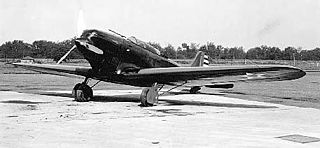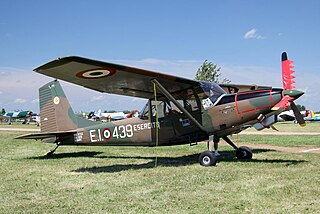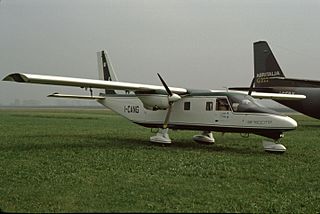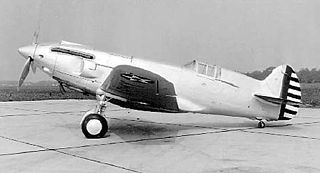Related Research Articles

The McDonnell XF-88 Voodoo was a long-range, twin-engine jet fighter aircraft with swept wings designed for the United States Air Force. Although it never entered production, its design was adapted for the subsequent supersonic F-101 Voodoo.

The Lockheed-Detroit YP-24 was a 1930s prototype two-seat fighter aircraft. An attack version called the A-9 was also proposed. The YP-24 is most remarkable for being the first fighter aircraft to bear the Lockheed name.

The Martin P5M Marlin, built by the Glenn L. Martin Company of Middle River, Maryland, was a twin piston-engined flying boat that entered service in 1951, and served into the late 1960s with the United States Navy performing naval patrols. It also served with the United States Coast Guard and the French Navy. 285 were produced.

The Convair R3Y Tradewind was an American 1950s turboprop-powered flying boat designed and built by Convair.

The Douglas A2D Skyshark was an American turboprop-powered attack aircraft built by the Douglas Aircraft Company for the United States Navy.

The Curtiss-Wright X-19, company designation Model 200, was an American experimental VTOL tiltrotor quadcopter airplane of the early 1960s.

The Lockheed P-7 was a four turboprop-engined patrol aircraft ordered by the U.S. Navy as a replacement for the P-3 Orion. The external configuration of the aircraft was to be very similar to that of the P-3. Development had not progressed very much before the program was cancelled in July 1990 as a cost-cutting measure following the end of the Cold War.

The Vought SBU-1 Corsair was a two-seat, all-metal biplane dive bomber built by Vought Aircraft Company of Dallas, Texas for the US Navy. Its design was based upon the F3U-1 two-seat fighter that was abandoned when the Navy decided not to obtain any more two-seat fighters.

The Cessna 421 Golden Eagle is an American six or seven seat twin-engined light transport aircraft, developed in the 1960s by Cessna as a pressurized version of the earlier Cessna 411.

The Douglas A-33 was an updated version of the Northrop A-17 for the export market, with a more powerful engine and increased bomb load.
Boeing XB-55 was a proposed Boeing aircraft designed to be a strategic bomber. The XB-55 was intended to be a replacement for the Boeing B-47 Stratojet in United States Air Force (USAF) service.

The Republic XF-84H "Thunderscreech" was an experimental turboprop aircraft derived from the F-84F Thunderstreak. Powered by a turbine engine that was mated to a supersonic propeller, the XF-84H had the potential of setting the unofficial air speed record for propeller-driven aircraft, but was unable to overcome aerodynamic deficiencies and engine reliability problems, resulting in the program's cancellation.

The Boeing B-1 was a small biplane flying boat designed by William Boeing shortly after World War I.

The SIAI-Marchetti SM.1019 is an Italian STOL liaison monoplane built by SIAI-Marchetti for the Italian Army, and based on the Cessna O-1 Bird Dog.

The Vulcanair SF.600 Canguro was a feederliner developed in Italy in the late 1970s. Despite a number of attempts to put the aircraft into series production, only a small number were ever built. The Canguro was a high-wing cantilever monoplane of conventional configuration with a fuselage of rectangular cross-section and a high-set tail. The tricycle undercarriage was not retractable, and its main units were carried on sponsons on the fuselage sides. SIAI Marchetti provided funding towards the construction of the prototype, and constructed this aircraft at the former Aviamilano plant. After flight testing proved positive, the type was put on sale, but failed to attract buyers in any number, even when the original piston engines were exchanged for turboprops and retractable undercarriage was offered as an option.

The Boeing Model 6D, a.k.a. Boeing Model 6E, Boeing B-1D and Boeing B-1E, was an American pusher biplane flying-boat built by Boeing between 1928 and 1929.

The Boeing Model 81 was an American training aircraft built by Boeing in 1928. The Model 81 was a development of the Model 64. It was powered by a newly developed engine, the 125 hp Fairchild-Caminez 4-cylinder radial engine. Operating at a much lower rpm than most engines it required the use of a large high-pitch propeller.

The Stearman XBT-17 was a prototype 1940s American two-seat low-wing monoplane primary trainer designed and built by Stearman Aircraft. It was evaluated by the United States Army Air Force in 1942 as the XBT-17.

The Curtiss P-37 was a fighter aircraft made by Curtiss-Wright in 1937. A development of the Curtiss P-36 Hawk, the P-37 never entered production.

The Boeing XPB was an American twin-engined biplane long-range patrol flying boat of the 1920s. A single example was built for the United States Navy.
References
Citations
Bibliography
- Andrade, John. U.S. Military Aircraft Designations and Serials since 1909. Hinckley, UK: Midland Counties Publications, 1979. ISBN 0-904597-22-9.
- Bowers, Peter M. Boeing Aircraft since 1916. London: Putnam, Third edition, 1989. ISBN 0-85177-804-6.